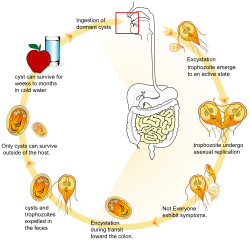Microbial cyst

A microbial cyst is a resting or dormant stage of a microorganism, usually a bacterium or a protist or rarely an invertebrate animal, that helps the organism to survive in unfavorable environmental conditions. It can be thought of as a state of suspended animation in which the metabolic processes of the cell are slowed down and the cell ceases all activities like feeding and locomotion. Encystment also helps the microbe to spread easily, from one host to another or to a better environment. When the encysted microbe reaches an environment good for its growth and survival, the cyst wall breaks down by a process known as excystation.
Unfavorable environmental conditions trigger the making of a cyst. These include the lack of nutrients or oxygen, extreme temperatures, lack of moisture and presence of toxic chemicals, which are not good for the growth of the microbe.[1]
Composition of the cyst wall
Different organisms have cyst walls made of different things. The cyst walls of bacteria are formed by the thickening of the normal cell wall with added peptidoglycan layers. The walls of protozoan cysts are made of chitin,[2] a type of glycoprotein. Nematode cyst walls are made of chitin reinforced by collagen.
Microbial Cyst Media
Cyst of Artemia salina
References
- ↑ Eugene W. Nester, Denise G. Anderson, C. Evans Roberts Jr., Nancy N. Pearsall, Martha T. Nester; Microbiology: A Human Perspective, 2004, Fourth Edition, ISBN 0072919248
- ↑ Anuradha Guha-Niyogi, Deborah R. Sullivan and Salvatore J. Turco; Glycoconjugate structures of parasitic protozoa; Glycobiology, 2001, Vol. 11, No. 4 45R-59R



